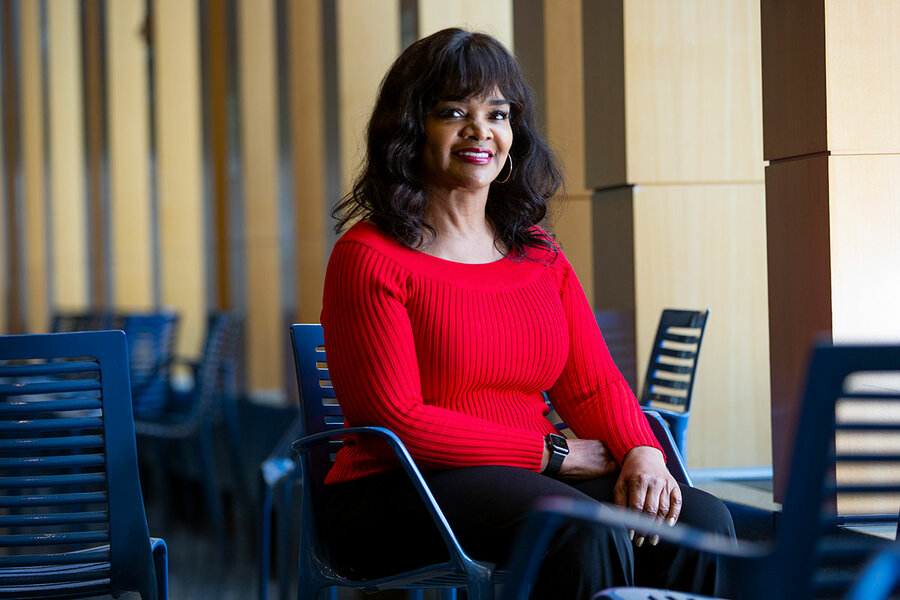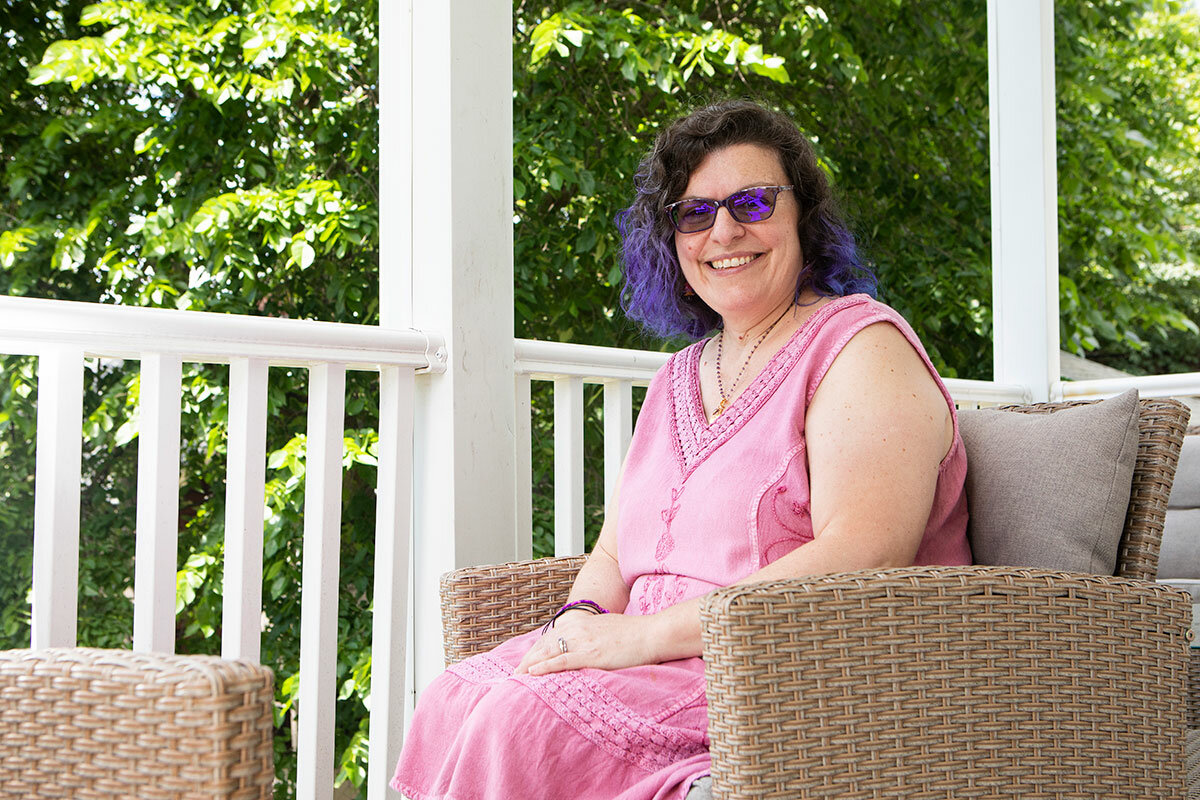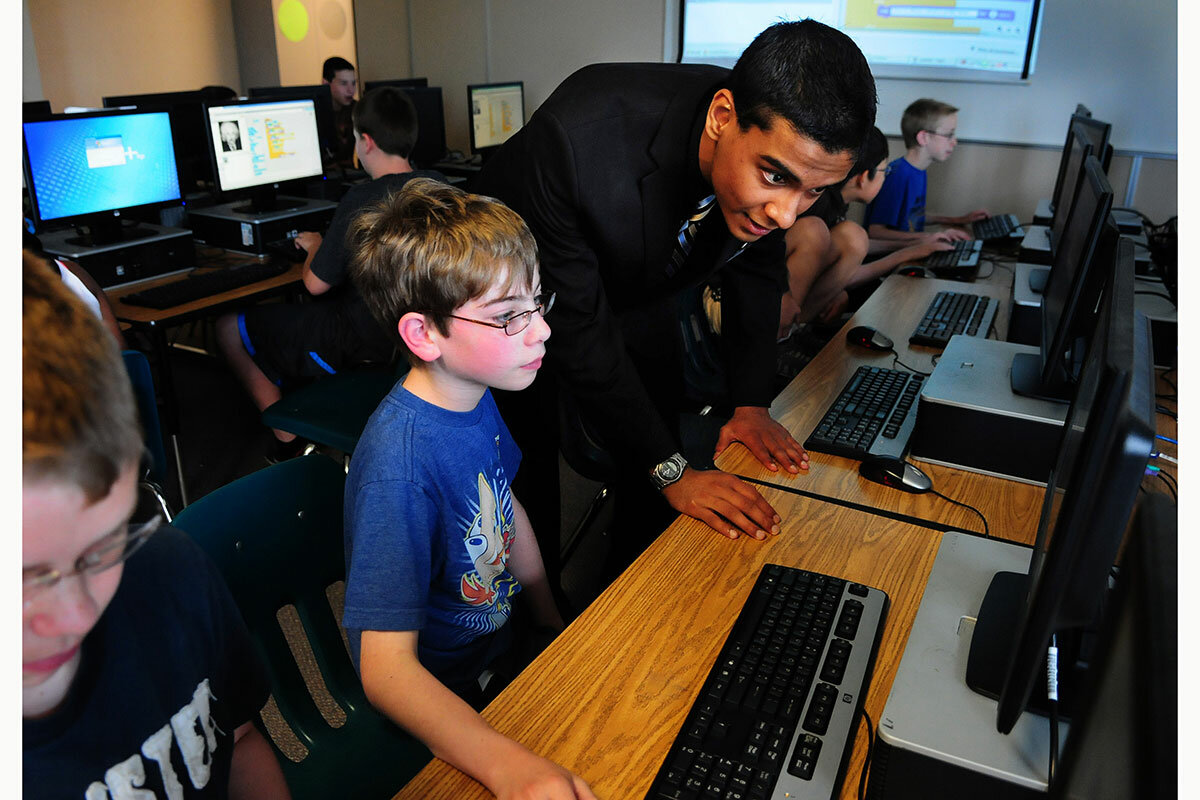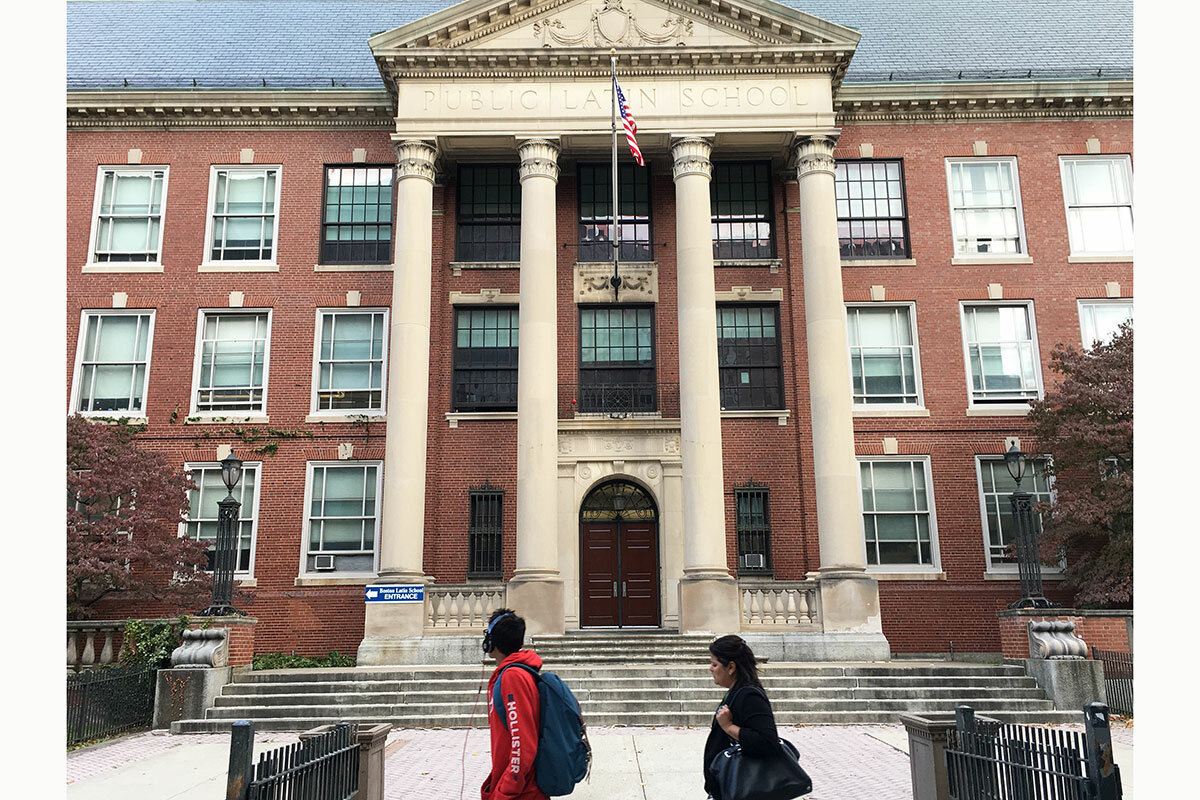Citizen building: What’s the best way to help students soar in a democracy?
Loading...
A fight in Boston over the future of training gifted students is at once an intensely local dispute, and part of a broader national debate about meritocracy and access to public education.
That debate, which goes back decades, centers on what most strengthens the social, political, and economic fabric of a democratic nation. Is it an education system that sorts students by academic ability – often giving top students more resources and the opportunity to move ahead quickly – or one in which classrooms embrace all students in the expectation that equal access will drive a much broader number of kids higher and widen opportunity?
Why We Wrote This
Are we better off as a nation investing in a system where talented students can soar, or one in which everyone is educated equally? Can’t we have both? Boston offers a case study. Part 3 in a series.
The gifted program in Boston is a lifesaver that ought to be expanded, so more students like hers can benefit, says parent Cathy Ware.
But some critics argue that children from Black, Latino, and Indigenous communities are underrepresented in accelerated offerings. Also, sorting high-achieving students into separate classrooms is a “total mismatch” for today’s global knowledge economy, says Michael Horn, an adviser on the future of education. He suggests that the best approach is to tailor instruction to individual students – via technology, for example.
“We ought to be keeping access to the ability to soar,” he says, “but putting a heck of a lot more resources and belief into the fact that many more can.”
When Cathy Ware’s son was in the third grade, he struggled to stay engaged and was frequently disruptive.
But when he tested into Boston’s gifted and talented program, known as Advanced Work Class, in the fourth grade, his behavior problems vanished. No longer bored, he loved school.
As Ms. Ware sees it, the decades-old program is a lifesaver that ought to be expanded, so more students can benefit from its challenging curricula.
Why We Wrote This
Are we better off as a nation investing in a system where talented students can soar, or one in which everyone is educated equally? Can’t we have both? Boston offers a case study. Part 3 in a series.
“Kids who need to go farther, faster, that’s a special need, just like a kid who is having trouble reading,” she says.
But Edith Bazile, an education activist and former Boston Public Schools teacher, says AWC, which disproportionately enrolls white and Asian children, should be dismantled. She’s pushing district leaders to invest, instead, in Excellence for All, a newer competitor meant to bring rigorous coursework to whole classrooms of students, without entry test requirements.
In Ms. Bazile’s view, Advanced Work Class is blatantly inequitable, and the parents and teachers fighting to preserve it are “hoarding resources, instead of thinking about how to expand opportunity for everyone.”
The fight over the future of the two programs is at once an intensely local dispute, and part of a broader national debate about meritocracy and access to public education. That debate, which goes back to the birth of gifted education in the 19th century, centers on what most strengthens the social, political, and economic fabric of a democratic nation. Is it an education system that sorts students by academic ability – often giving top students more resources and the opportunity to move ahead quickly – or one in which classrooms embrace all students in the expectation that equal access will drive a much broader number of kids higher and widen opportunity?
For some, educators, it’s a false dichotomy.
“That tension has been around for years – the trade-off between excellence and equity,” says James Borland, a professor of education at Columbia University’s Teachers College. “I don’t think we need to choose between them.”
The debate in Boston over how to support younger students comes as elite exam high schools on both coasts are rethinking their reliance on grades and test scores in admissions decisions. Some schools have changed their entrance criteria, aiming to expand access to more Black and Latino students. But those schools have faced pushback – and lawsuits – from some parents and alumni, who say the changes discriminate against Asian Americans and undermine the notion of merit.
And Boston is not the only city wrestling with what to do about gifted education in the early grades. In New York City last year, outgoing mayor Bill de Blasio announced a plan to phase out gifted education for elementary schoolers in favor of “accelerated” learning for all students. His successor, Eric Adams, opted to expand the gifted and talented program instead.
When gifted classrooms and schools were created in the late 1800s, they were seen as a way to ensure that the nation’s most promising students reached their full potential. Subsequent studies have found that for some students, the programs have done just that.
Yet the approach has long been criticized for underrepresenting talented Black, Latino, and Indigenous students and increasing segregation in the nation’s public schools. Some say the programs take resources away from needier students.
Michael Horn, an author and adviser on the future of education, says sorting high-achieving students into separate classrooms might have worked in the past, when Americans didn’t need a college credential to earn a living wage. But it’s a “total mismatch” for today’s global knowledge economy, in which all students need to be educated to a higher level to succeed.
The solution, Mr. Horn says, lies in training teachers to better tailor their instruction to individual students’ strengths and weaknesses – a common pedagogical practice known as “differentiation.”
But catering to kids with widely different abilities isn’t easy, especially in large classes with only one teacher. Often, parents of high-achieving children in regular classrooms worry that their kids are being overlooked by their overburdened teachers, who must focus their energy on students who are struggling.
“The students who get the least attention are the ones who are doing well,” says Ms. Ware, whose son was often told to read a book when he was done with his work.
Questions about equity
In a recent study of the Excellence for All program, which is in classrooms in grades four through six, teachers said they felt exhausted trying to “serve all students’ needs to the best of their ability.” Asked what could make the program more successful, they collectively responded: “more bodies in the classroom.”
More homogeneous “accelerated” classrooms, like the ones that Advanced Work Class creates for fourth through sixth graders, are easier for teachers to manage. Advanced students, like Ms. Ware’s son, can tackle complex texts and math problems, without having to wait for the rest of the class to catch up.
“It feels more like teaching high school English than a typical elementary class,” says Roxanne Saravelas, a longtime AWC teacher in the William Ohrenberger school in West Roxbury, a neighborhood in Boston. In the last full school year before the pandemic, her students showed levels of academic growth in English language arts that were well above school, district, and state averages, with Black and Latino students performing at the same level as their white peers, according to data she shared.
“This could be something that could help close the achievement gap, if it were targeted to children of color who are showing academic promise,” Ms. Saravelas says.
A recent review of Advanced Work Class found that it boosts high school graduation and college enrollment rates, particularly among Black and Latino students. That increase does not seem to be due to teacher quality – though accelerated classrooms often employ veteran teachers – or to the positive “peer effects” of being surrounded by high-ability peers. Rather, it seems that enrolling in Advanced Work Class sets students of color on a trajectory for success, making them more likely than similar students in regular classrooms to meet milestones like taking the SAT – and less likely to fall off the track to graduation in the 11th or 12th grade.
For years, though, Black and Latino kids have made up a minority of students enrolled in Advanced Work Class. During the 2020-2021 academic year, Black and Latino students accounted for close to three-quarters of students in Boston Public Schools, but just under a quarter of students in the fourth grade cohort of AWC.
“The supreme irony is that this program underrepresents the very group that the benefits are largest for,” says Sarah Cohodes, an associate professor of economics and education at Teachers College, and author of the study.
It was this glaring disproportionality that led a team of researchers commissioned by Boston Public Schools nearly a decade ago to recommend that the district convert all classrooms in grades four to six to Advanced Work Class “with high expectations and rigorous coursework” – and prompted then-Superintendent Tommy Chang to create Excellence for All to fulfill that goal.
Dr. Chang, who came to Boston from Los Angeles shortly after the researchers released their report in 2014, says he was shocked to discover that the district was still sorting students in elementary school. Most districts stopped “tracking” students into separate classrooms in the early grades decades ago, he says.
He recalls walking the halls of one elementary school early in his tenure and seeing an AWC class on one side of the hall, and the “regular” class on the other.
“It was very clear, it was separated by race, and unequal opportunities were being offered,” he says.
Excellence for All, which aims to improve instruction in writing and math – while expanding students’ access to enrichments like coding, robotics, and world languages – was created “to challenge the idea that we needed to give students a test and segregate them to get high rigor,” says Colin Rose, then an assistant superintendent in charge of reducing racial inequities in Boston Public Schools. “Advanced Work Class,” he adds, is “antithetical to the values we are promoting for equity.”
A consideration: student morale
Though Dr. Chang never formally proposed eliminating Advanced Work Class, rumors that he might alarmed parents like Prince Charles Alexander, who see the program as the surest route to Boston’s elite exam schools. Mr. Alexander, a recording and mixing engineer whose work has garnered Grammy Awards and nominations, credits much of his professional success to Boston Latin School, and he wanted his twins, now 10, to be ready to attend.
“When people tell you that you’re good, you feel good. When people tell you you’re doing well, you feel like you can do well,” says Mr. Alexander, who teaches at the Berklee College of Music. “My life has been colored by Boston Latin because I feel like I succeeded at something that was hard to do.”
His boy-girl twins, who were ultimately admitted to the Ohrenberger Advanced Work Class in the fourth grade, “understand that AWC is pulling them towards a certain excellence,” he says.
Still, Mr. Alexander, who is Black, recognizes that the affirmation his children get from Advanced Work Class has a flip side, and he’s troubled by the program’s racial imbalance.
“You’ve got the AWC kids saying ‘I got it going on,’ and you have the other kids saying ‘I don’t,’” he says. “That’s one of the problems of creating an elite class within a school with a large minority population, when the elite class is primarily nonminority.”
Julia Bott, the principal of the Ellis Mendell Elementary School in Roxbury, another Boston neighborhood, saw those dynamics at play in her own school before it joined Excellence for All. When children abandoned her school in fourth grade for a school offering Advanced Work Class, the remaining students would make comments about how the smart kids were leaving, she says.
“What does that do to a child when, in the fourth grade, they start to internalize beliefs about their intellectual capacity?” she says.
When the district rolled out Excellence for All in 2016, Ms. Bott jumped at the chance to join. A firm believer in inclusion, she’d done away with separate classes for students with disabilities, but found some teachers were struggling to target instruction in the upper elementary grades, when the gaps between students grew larger. Excellence for All aligned with her own values, and provided her teachers with training in writing instruction and math.
That first year, 13 schools joined Excellence for All, including three that switched from Advanced Work Class to do so. Today, there are 15 schools that offer Excellence for All, and four that offer Advanced Work Class, down from 22 in 2014.
When the pandemic hit, the district stopped administering the AWC entrance exam, allowing schools to choose between offering the program to all students, and letting students opt into it. Last summer, a working group on the program’s future recommended that the district permanently suspend testing into Advanced Work Class, but stopped short of calling for the program’s elimination. District leaders will bring their own recommendations and implementation plan to the school committee this fall, a spokesperson says.
In the meantime, a natural experiment in inclusion is playing out in the Ohrenberger school, where admission to Advanced Work Class has been open to all students for the past two years. Some of the fourth graders now in the program were recommended by teachers; others requested a spot.
Ms. Saravelas, one of two AWC teachers there, says it’s been more challenging teaching this year’s fourth graders than a typical cohort, though it’s hard to say how much of that is due to the disruptions of the pandemic.
“We are giving those kids who are raising their hands the opportunity to give it a try,” she says.
Meanwhile, Mr. Horn, the author, says both sides of the debate over gifted education are “missing an opportunity to create a model that personalizes for each student.”
He argues that new technologies, which allow children to work independently while teachers roam the classroom, checking on their progress and providing support, have made personalized learning easier than it used to be.
“We ought to be keeping access to the ability to soar,” he says, “but putting a heck of a lot more resources and belief into the fact that many more can.”
This story is the third in a four-part series:
Part 2: How should schools teach children what it means to be an American?
Part 3: Are we better off as a nation investing in a system where talented students can soar, or one in which everyone is educated equally? Can’t we have both?
Part 4: How has parental participation in public schools shaped U.S. education?










